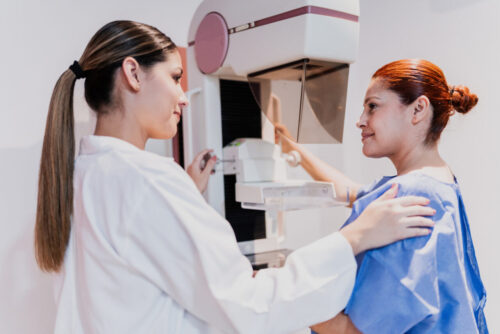Demystifying Mpox, the Latest Public Health Emergency
August 16, 2022
By Cassandra M. Pierre, MD, MPH, By Glory Ruiz, MD, By Samantha Johnson

Mario Tama, Getty Images
In response to the Biden Administration's declaration, experts set the record straight on what mpox, previously called monkeypox, is and the public health response.
On Friday August 5, the U.S. declared mpox, then called monkeypox, a public health emergency. In response, Cassandra Pierre, MD, MPH, infectious disease physician, medical director of public health programs, and the associate hospital epidemiologist at Boston Medical Center (BMC); Glory Ruiz, MD, the director of public health programs at BMC; and Samantha Johnson, operations manager of public health outreach, education, and prevention sat down for a roundtable discussion about mpox, common misconceptions, prevention, the mpox vaccine, and more. Marquis Jamison, program manager of HIV/STI prevention & screening contributed information to this discussion.
What is mpox?
Cassandra Pierre, MD, MPH: Mpox is caused by the mpox virus, which is related to the smallpox virus. It is not a new disease. It was first identified in monkeys in 1958 and humans in the 1970s.
The west African variant that is currently spreading during this outbreak is rarely fatal, it has a very low mortality rate. In this particular outbreak, so far, among infections experienced in Europe, North America, South America, Asia, and other non-endemic places in Sub-Saharan Africa, we have seen only a handful of fatalities from the infection.
Glory Ruiz, MD: Although it’s typically a mild disease, it can be extremely painful.
What are the symptoms of mpox?
HealthCity: There is confusion around what mpox looks like. How can providers tell the difference between any common rash and mpox?
CP: Honestly, even for physicians, it can be difficult because it can resemble rashes caused by other infectious diseases (including herpes simplex, syphilis, or chickenpox). Although the typical rash of mpox is a fluid-filled pustule that can evolve into sores, this particular outbreak is characterized by a rash that can appear as a pimple, a solitary bumps, or even folliculitis (inflammation of the hair follicles) before developing the more typical rash associated with mpox. This particular outbreak is characterized by a rash and sores, as well as ulcers that are non-healing. During this outbreak, the rash can be confined to genital areas, the anus, face, and hands. They can initiate as something that looks very minor, like a pimple, and either remain local or turn into an all-over body rash.
Now, in a season when people have heat rashes, and others have eczema or acne, it’s important to know that if you have an underlying condition that’s associated with a rash don’t raise your panic level if it’s consistent with your diagnosis.
It’s the other mpox symptoms in addition to the rash that help differentiate it. Lymphadenopathy, swelling of your lymph nodes, is common. You can have a fever, chills, body aches, and other flu-like symptoms. We’ve also seen proctitis [rectal inflammation and pain] which was not seen with previous mpox outbreaks.
Also make note of whether there’s a cluster of rashes in the household, family, or social networks.
A subset of people — especially including those who are immunocompromised, who are pregnant or breastfeeding, children under the age of 8, and those with eczema or atopic dermatitis — can have severe disease. During this outbreak, however, severe disease has rarely been reported.
HC: How can patients or their providers determine a mpox rash on Black or brown skin tones? Does it differ from white/fair skin? Is this a concern?
Interestingly, we probably have more data on how to diagnose mpox rashes on darker skin, considering all the photos taken of mpox lesions prior to May 2022 were of individuals infected in the endemic regions of sub-Saharan Africa. In fact, some of my patients felt that there was stigmatization of Black people in the early reporting on mpox since all the photos were stock photos of Black people that journalists pulled from the internet.
Traditionally, mpox has presented as a blister-filled bump (pox) or an ulcer — both easy enough to identify regarding of skin tone. This current outbreak has presented more atypically — potentially appearing as a small, solitary pimple in the early stage of infection — lesions may be more difficult to tie to mpox regardless of skin tone. My hope is that lesions on dark and pale skin alike will elicit careful evaluation.
Who can get mpox, how it is spread, and differences from COVID-19
CP: Mpox is a disease spread via prolonged contact, primarily. That means face-to-face contact either through direct, sustained skin-to-skin contact or through transmission of infectious respiratory secretions that are emitted by talking, laughing, singing, or breathing. It can also be transmitted through indirect contact through shared linens, sheets, clothing, etc. It is important to note that though we are seeing higher numbers among men who have sex with men (MSM), this is not a disease that solely affects that population. Anyone can get mpox if they encounter someone with the infection and meet any of the above criteria about how the disease is spread.
HC: When you say “respiratory secretions,” that automatically raises COVID-19 alarm bells. Are there similarities in that aspect of how mpox is spread?
CP: It’s important not to conflate mpox and COVID-19. These are very different diseases. We don’t have to revert to panic mode because of an emerging infectious disease.
It’s important not to conflate mpox and COVID-19. These are very different diseases. We don’t have to revert to panic mode because of an emerging infectious disease.
Mpox requires really intimate, prolonged, physical or face-to-face contact. We’re defining “face-to-face” as contact without a mask for longer than three hours — that’s the bar. In opposition, as healthcare workers we say the threshold for credible COVID-19 exposure is 10 to 15 minutes in conversation with a COVID-positive person. Moreover, for mpox most cases are transmitted via direct contact, less through respiratory secretions.
GR: That’s why mpox, despite common misconception, is not considered a sexually transmitted infection at this point.
Mpox stigmatization of men who have sex with men
HC: That is a common misconception about mpox, that it’s sexually transmitted and it’s only among MSM.
Samantha Johnson: A lot of our patients have felt that the way that mpox is being approached in the media is very similar to HIV. It’s been very stigmatizing, especially with such a focus on Provincetown. For a lot of our patients, it feels like an impact on their community since ‘P-town’ is such an ingrained part of the LGBTQ community in Massachusetts.
HC: At the same time, MSM are getting mpox and need outreach from health systems. How can providers and systems provide outreach without stigmatization?
CP: With any disease, we must track where it’s happening, who is most affected, and who is being infected. It’s must-have data to allocate our resources and tailor outreach appropriately. It should not be information that’s used to stigmatize individuals, because we know that viruses don’t have bias.
A lot of our patients have felt that the way that mpox is being approached in the media is very similar to HIV. It’s been very stigmatizing.
Unlike in the HIV epidemic of the 1980s, where it felt like the public health response was, “this is a disease of gay people, we can ignore it,” the data on mpox helps us highlight those most affected so it can be a call to action to divert resources. And, for mpox, we do have testing, the vaccine, and treatment to offer. We just need to make sure the people with the most risk are being allocated resources.
The mpox vaccine
GR: Right now the criteria for vaccine eligibility is limited to those with a known sexual partner who was diagnosed with mpox or someone who has had more than one sexual partner in the last 14 days.
CP: JYNNEOS, the vaccine that we are using for mpox vaccination, was originally developed as a counter measure against smallpox and mpox and was stockpiled, but its use was not anticipated for an outbreak like this. So, while production is being scaled up, the resources remain constricted. However, because it is not new, we know it is safe and effective—though the full data on its effectiveness for this particular outbreak will be tracked as we distribute.
We are setting up mpox vaccine distribution as post-exposure prophylaxis. Most vaccines, you think of them as prevention for future exposure, but we have data with JYNNEOS to say that this is effective in reducing disease onset—because the incubation period is anywhere from 2 to 3 weeks, longer than COVID. So, if you give the mpox vaccine with 14 days from time of exposure, you can mitigate severity of disease of someone already infected.
Rather than mass vaccination like with the COVID-19 vaccines, with our supply, we are looking at behavior risk and exposure as indication for a vaccination. Additionally, many states, including Massachusetts are recommending one dose of the vaccine instead of two. Let us be clear: one dose of this vaccine provides immediate immunity for our community, with the second providing long-term immunity. Shifting from a two to one dose recommendation ensures that more members of our community will be protected against immediate infection.
Comprehensive healthcare opportunities with mpox treatment
GR: We spoke about resources, and that doesn’t just mean the mpox vaccine. Resources help ensure that people who are seeking the vaccine or treatment for mpox are getting comprehensive healthcare. For example, if a person has been exposed to mpox through physical contact via sex, we can offer extensive panels of STI testing and prevention. In our experience at Boston Medical Center, confirmed mpox cases are debuting with co-occurring sexually transmitted infections—that’s the bad news. The good news is that by helping people with mpox, we offer comprehensive healthcare, such as starting HIV pre-exposure prophylaxis.
CP: We really do not want to trade one emerging infectious disease for another.
GR: Specifically because July and August are the months of the year that we have the highest number of syphilis infections and the highest number of HIV seroconversions. I cannot wrap my head around sacrificing one thing for the other knowing that.
CP: Our focus on comprehensive health is also important for comprehensive data collection. In addition to MSM being the most predominantly affected group at this point, we’re also seeing people of color heavily affected. This is similar to the COVID-19 pandemic. It highlights, potentially, longstanding health disparities for MSM and POC.
This is part one of the roundtable discussion on mpox. For part two, which delves into misinformation, and three, which focuses on the particular concerns of healthcare workers, stay tuned.


